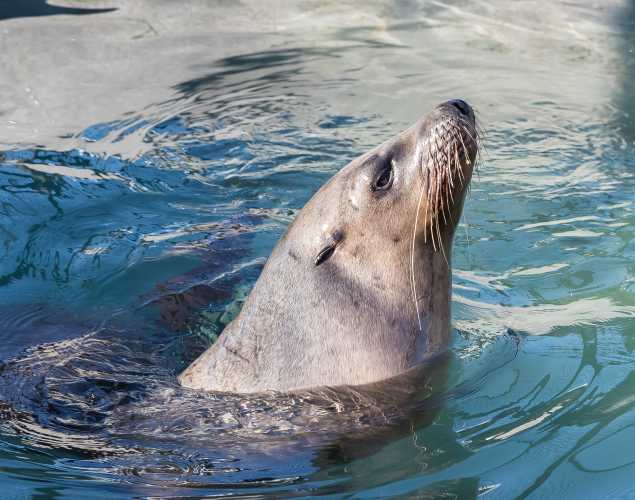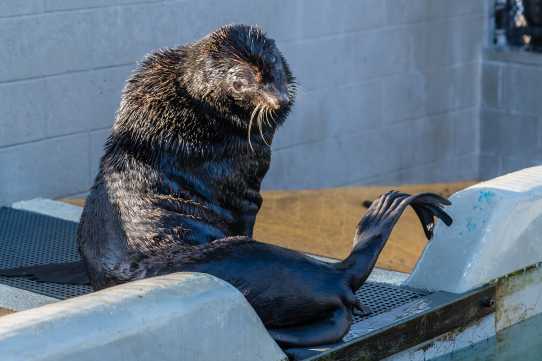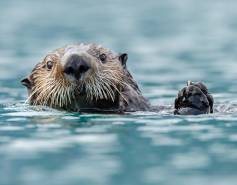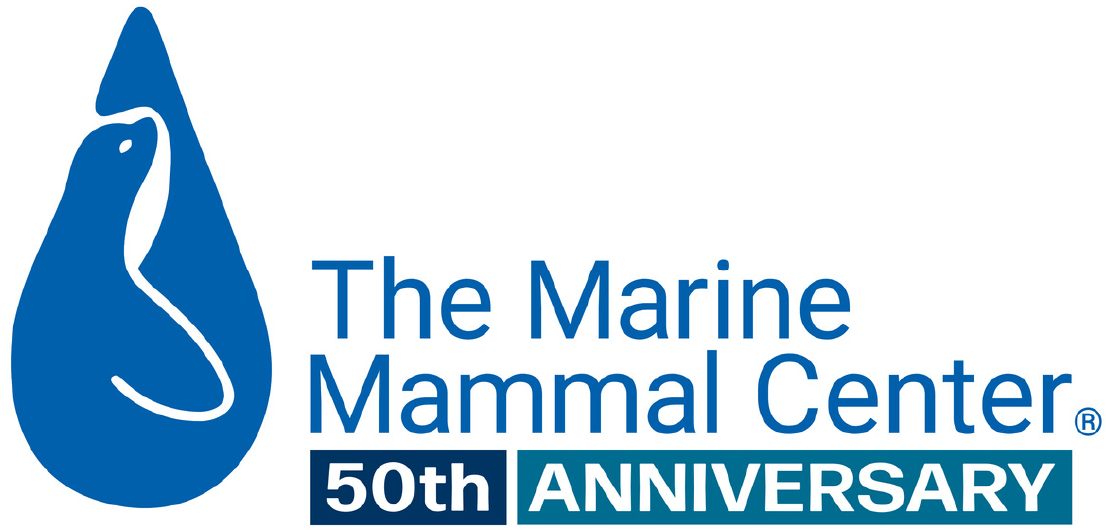
Red Tides and Domoic Acid Toxicity
In 1998, The Marine Mammal Center diagnosed the first case of domoic acid toxicosis in marine mammals.
This condition is caused by harmful algal blooms, sometimes referred to as “red tides.”
What Is Domoic Acid?
Domoic acid is produced during certain harmful algal bloom events by a type of algae called Pseudo-nitzschia australis. This neurotoxin accumulates in small fish, like sardines and anchovies, which are then eaten by marine mammals like sea lions in large quantities.
Domoic acid attacks the brain and the heart causing seizures and heart failure. If left untreated, it usually causes permanent brain damage. The toxin will naturally flush from an animal’s system over time, but sea lions repeatedly exposed to the toxin will suffer longer-lasting and more serious effects.
If these animals come into our care before significant damage occurs, we are often able to help flush the toxin from their systems by giving them fluids. We also provide them with a fish source that is free of domoic acid. To control any seizures, our veterinarians give these patients anti-seizure medications that are also used in humans.
The Center’s veterinary team is investigating new therapies to reduce the amount of inflammation and damage the brain experiences while the animal is recovering.
Although most of the patients we treat for domoic acid toxicity are California sea lions, other marine mammals are susceptible to its effects as well. Domoic acid has been reported in a number of other seal and sea lion species, as well as cetaceans such as blue and humpback whales. In 2014, researchers at the Center were the first to detect domoic acid in Guadalupe fur seals, a threatened species.
Domoic acid can also affect humans who eat contaminated crab, shellfish and fish, causing a life-threatening condition known as amnesiac shellfish poisoning. Because sea lions are often the first to be affected by a toxic algal bloom, the Center provides data to the public health department when domoic acid poisonings are detected. This helps public health officials determine whether seafood warnings should be issued and allows scientists to better understand local ecosystem health.
Through testing and closing dangerous fisheries, we’ve gotten better at preventing humans from getting sick from domoic acid, but these efforts don’t work for marine mammals. And there’s still a lot we don’t know about what causes massive algal blooms like the ones we’ve seen in recent years—or even why the Pseudo-nitzschia algae produces the toxin.
One thing we do know is that the algae thrives in unusually warm waters off the West Coast—ocean conditions that have become more frequent in recent years as we see the impacts of climate change increase. Center scientists collaborate with other oceanographers and climate scientists to investigate the links with climate change and other environmental factors.
Meet One of Our Patients
Northern fur seal Inky was found weak and starving, although you might not have suspected it since he weighed over 215 pounds when admitted. Inky is the largest northern fur seal ever cared for at our hospital, but still weighed about half of what he should have as an adult male.
Lab results confirmed that Inky was suffering from domoic acid, a potentially deadly neurotoxin. Luckily, he was rescued before any significant damage was done. Veterinarians flushed the toxin from his system, and after being granted a clean bill of health, Inky was released back to his ocean home.

Domoic Acid Toxicosis Research at The Marine Mammal Center
The Marine Mammal Center diagnosed the first case of domoic acid poisoning in marine mammals because of a large outbreak in California sea lions in 1998. Since then, our veterinarians and scientists have contributed to a number of scientific papers on domoic acid poisoning.
{"image":"\/Animals\/Wild\/Sea otter\/cropped-images\/sea-otter-face-shutterstock-423-0-3176-2481-1602701548.jpg","alt":"southern sea otter","title":"Clinical Signs and Pathology Associated With Domoic Acid Toxicosis in Southern Sea Otters","link_url":"https:\/\/www.marinemammalcenter.org\/publications\/clinical-signs-and-pathology-associated-with-domoic-acid-toxicosis-in-southern-sea-otters","label":"Research Paper","type":"publication"}

Clinical Signs and Pathology Associated With Domoic Acid Toxicosis in Southern Sea Otters
Read More{"image":"\/Animals\/Wild\/California sea lion\/cropped-images\/sea-lion-pup-shutterstock-451-142-3018-2358-1603915228.jpg","alt":"California sea lion pup","title":"Domoic Acid in Fetal Fluids of California Sea Lions","link_url":"https:\/\/www.marinemammalcenter.org\/publications\/domoic-acid-in-fetal-fluids-of-california-sea-lions","label":"Research Paper","type":"publication"}

{"image":"\/Animals\/Wild\/Steller sea lion\/cropped-images\/steller-sea-lion-harem-shutterstock-648-0-4424-3456-1603916879.jpg","alt":"Group of Steller sea lions","title":"Algal Toxins in Alaskan Marine Mammals Foraging in a Changing Environment","link_url":"https:\/\/www.marinemammalcenter.org\/publications\/algal-toxins-in-alaskan-marine-mammals-foraging-in-a-changing-environment","label":"Research Paper","type":"publication"}

{"image":"\/Places\/Coastal landscapes\/cropped-images\/algal-bloom-washington-state-shutterstock-159-0-3840-3000-1603917390.jpg","alt":"algal bloom off the coast of Washington state","title":"Unprecedented Toxic Algal Bloom Linked to Unusual Ocean Conditions","link_url":"https:\/\/www.marinemammalcenter.org\/publications\/unprecedented-toxic-algal-bloom-linked-to-unusual-ocean-conditions","label":"Research Paper","type":"publication"}

Domoic Acid in the News
{"image":"\/Animals\/Patients\/California sea lions\/cropped-images\/LA Times Front Page 8.13.24-340-15-1270-992-1723588213.png","alt":"LA Times Front Page Domoic Acid Sea Lions","title":"LA Times: Neurotoxin is Poisoning Large Numbers of Sea Lions","link_url":"https:\/\/www.marinemammalcenter.org\/news\/la-times-neurotoxin-is-poisoning-large-numbers-of-sea-lions","label":"In the News","date":"2024-08-13 02:00:00","type":"news"}

{"image":"\/Animals\/Patients\/California sea lions\/2024\/cropped-images\/musty - csl - bill hunnewell-180-0-1270-992-1723649438.jpg","alt":"California sea lion being treated for domoic acid poisoning","title":"NBC Nightly News: Researchers Investigate Dozens of Sick Sea Lions Along California Coast","link_url":"https:\/\/www.marinemammalcenter.org\/news\/nbc-nightly-news-researchers-investigate-dozens-of-sick-sea-lions-along-california-coast","label":"In the News","date":"2024-08-13 02:00:00","type":"news"}

NBC Nightly News: Researchers Investigate Dozens of Sick Sea Lions Along California Coast
August 13, 2024
Read More{"image":"\/Animals\/Patients\/California sea lions\/2020\/cropped-images\/csl-chai-by-bill-hunnewell-c-the-marine-mammal-center-0-294-1994-1557-1604428596.jpg","alt":"California sea lion Chai","title":"KAZU: An Annual Sea Lion Sickness Is Linked To Climate Change","link_url":"https:\/\/www.marinemammalcenter.org\/news\/kazu-an-annual-sea-lion-sickness-is-linked-to-climate-change","label":"In the News","date":"2020-06-23 05:00:00","type":"news"}

{"image":"\/Animals\/Patients\/California sea lions\/cropped-images\/csl-ledge-by-bill-hunnewell-c-the-marine-mammal-center-394-10-2918-2279-1604525467.jpg","alt":"California sea lions in rehabilitation","title":"Sea Lions Are the Latest Species Impacted by Changing Ocean Conditions","link_url":"https:\/\/www.marinemammalcenter.org\/news\/sea-lions-are-the-latest-species-impacted-by-changing-ocean-conditions","label":"Patient Update","date":"2019-07-08 05:00:00","type":"news"}

Sea Lions Are the Latest Species Impacted by Changing Ocean Conditions
July 8, 2019
Read More